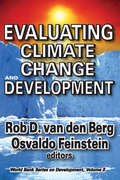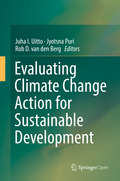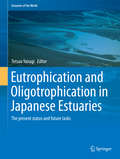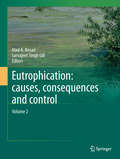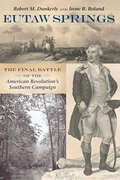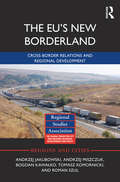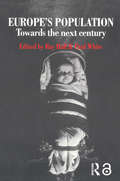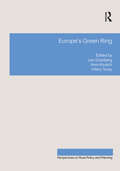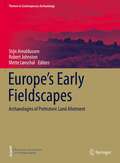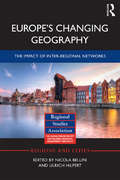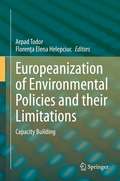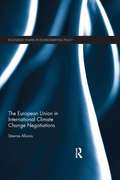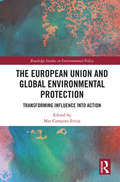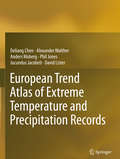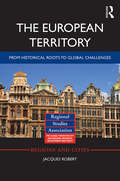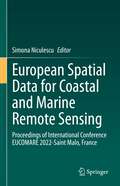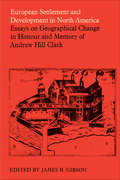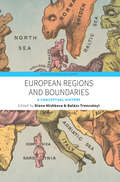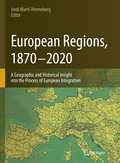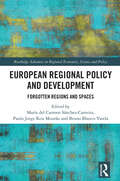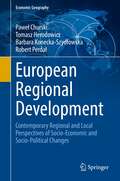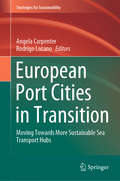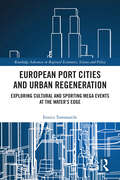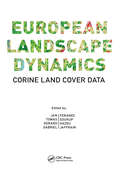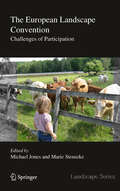- Table View
- List View
Evaluating Climate Change and Development: Volume 9, World Bank Series on Development (World Bank Series On Evaluation And Development Ser. #Vol. 8)
by Osvaldo N. FeinsteinClimate change has become one of the most important global issues of our time, with far-reaching natural, socio-economic, and political effects. To address climate change and development issues from the perspective of evaluation, an international conference was held in Alexandria, Egypt. This book distills the essence of that timely conference, building on the experiences of more than 400 reports and studies presented.Developing countries may be particularly vulnerable to the expected onslaught of higher temperatures, rising sea levels, changing waterfall patterns, and increasing natural disasters. All societies will have to reduce their vulnerability to these changes, and this book describes how vulnerabilities may be addressed in a systematic manner so that governments and local communities may better understand what is happening. Different approaches are also discussed, including the use of human security as a criterion for evaluation as well as ways to deal with risk and uncertainty. Evaluating Climate Change and Development presents a rich variety of methods to assess adaptation through monitoring and evaluation.The volume deals with climate change, development, and evaluation; challenges and lessons learned from evaluations; mitigation of climate change; adaptation to climate change; vulnerability, risks and climate change; and presents a concluding chapter on the road ahead. Collectively the authors offer a set of approaches and techniques for the monitoring and evaluation of climate change.
Evaluating Climate Change Action for Sustainable Development
by Rob D. van den Berg Jyotsna Puri Juha I. UittoThis book is open access under a Creative Commons license. This authoritative book presents the ever progressing state of the art in evaluating climate change strategies and action. It builds upon a selection of relevant and practical papers and presentations given at the 2nd International Conference on Evaluating Climate Change and Development held in Washington DC in 2014 and includes perspectives from independent evaluations of the major international organisations supporting climate action in developing countries, such as the Global Environment Facility. The first section of the book sets the stage and provides an overview of independent evaluations, carried out by multilateral development banks and development organisations. Important topics include how policies and organisations aim to achieve impact and how this is measured, whether climate change is mainstreamed into other development programs, and whether operations are meeting the urgency of climate change challenges. The following sections focus on evaluation of climate change projects and policies as they link to development, from the perspective of international organisations, NGO's, multilateral and bilateral aid agencies, and academia. The authors share methodologies or approaches used to better understand problems and assess interventions, strategies and policies. They also share challenges encountered, what was done to solve these and lessons learned from evaluations. Collectively, the authors illustrate the importance of evaluation in providing evidence to guide policy change to informed decision-making.
Eutrophication and Oligotrophication in Japanese Estuaries
by Tetsuo YanagiThis book presents lessons learnt from Japan's past, in relation to coastal waters, industrial pollutants and concentrated urban populations. It examines ecosystem damage and pollution in coastal sea areas and addresses the question: What is the present status of Japanese estuaries from the view point of eutrophication and oligotrophication? The authors describe three typical situations, namely eutrophication problems in Tokyo Bay, oligotrophication problems in the Seto Inland Sea, and the disappearance of hypoxia in Dokai Bay. Readers will learn how legal controls on Total Phosphorus (TP) and Total Nitrogen (TN) loads have played an important role in each of these three bays. They will see that the results of the application of the law differ among the three bays as the characteristics of material cycling are different. The roles of community activities, water related technology development and local characteristics emerge, as responses to problems of environmental deterioration and future tasks are all investigated in this publication. The book will appeal to anyone with an interest in maintaining healthy estuaries, or in coastal water environment affairs and governing systems.
Eutrophication: Causes, Consequences and Control
by Abid A. Ansari Sarvajeet Singh GillEutrophication continues to be a major global challenge and the problem of eutrophication and availability of freshwater for human consumption is an essential ecological issue. The global demand for water resources due to increasing population, economic developments, and emerging energy development schemes has created new environmental challenges for global sustainability. Accordingly, the area of research on eutrophication has expanded considerably in recent years. Eutrophication, acidification and contamination by toxic substances are likely to pose increasing threats to freshwater resources and ecosystems. The consequences of anthropogenic-induced eutrophication of freshwaters are severe deterioration of surface waters and growing public concern, as well as new interest among the scientific community. "Eutrophication: causes, consequences & control" provides the latest information on many important aspects of the processes of natural and accelerated eutrophication in major aquatic ecosystems around the world. This book offers a cutting-edge resource for researchers and students alike who are studying eutrophication in various ecosystems. It presents the latest trends and developments in the field, including: global scenarios and local threats to the dynamics of aquatic ecosystems, economics of eutrophication, eutrophication in the great lakes of the Chinese pacific drainage basin, photoautotrophic productivity in eutrophic ecosystems, eutrophication's impacts on natural metal remediation in salt marshes, phytoplankton assemblages as an indicator of water quality in seven temperate estuarine lakes in southeast Australia, biogeochemical indicators of nutrient enrichments in wetlands - the microbial response as a sensitive indicator of wetland eutrophication, and ultraviolet radiation and bromide as limiting factors in eutrophication processes in semi-arid climate zones. Written by respected experts and featuring helpful illustrations and photographs, "Eutrophication: causes, consequences & control" provides a concise and practical update on the latest developments in eutrophication.
Eutaw Springs: The Final Battle of the American Revolution's Southern Campaign
by Robert M. Dunkerly Irene B. BolandAn in-depth analysis of one of the War for Independence’s bloodiest and least understood conflicts.The Battle of Eutaw Springs took place on September 8, 1781, and was among the last in the War of Independence. It was brutal in its combat and reprisals, with Continental and Whig militia fighting British regulars and Loyalist regiments. Although its outcome was seemingly inconclusive, the battle, fought near present-day Eutawville, South Carolina, contained all the elements that defined the war in the South. In Eutaw Springs: The Final Battle of the American Revolution’s Southern Campaign, Robert M. Dunkerly and Irene B. Boland tell the story of this lesser known and under-studied battle of the Revolutionary War’s Southern Campaign. Shrouded in myth and misconception, the battle has also been overshadowed by the surrender of Yorktown.Eutaw Springs represented lost opportunities for both armies. The American forces were desperate for a victory in 1781, and Gen. Nathanael Greene finally had the ground of his own choosing. British forces under Col. Alexander Stewart were equally determined to keep a solid grip on the territory they still held in the South Carolina lowcountry.In one of the bloodiest battles of the war, both armies sustained heavy casualties with each side losing nearly twenty percent of its soldiers. Neither side won the hard-fought battle, and controversies plagued both sides in the aftermath. Dunkerly and Boland analyze the engagement and its significance within the context of the war’s closing months, study the area’s geology and setting, and recount the action using primary sources, aided by recent archaeology.“A well put together book that is easy to read, and it makes good use of graphic material. Eutaw Springs is recommended.” —The Journal of America’s Military Past“A long-overdue study of . . . Nathanael Greene’s last main force Southern campaign engagement. Drawing from a wealth of resources including new research, archaeology and pension documents, the authors have created an easy reading account. . . . For students of the Revolutionary War, this is must reading because so much focus has been directed at Yorktown where the British abandoned an army instead of the more mobile war in the South where the war was finally won by wearing down the British.” —Lawrence Babits, George Washington Distinguished Professor of History, East Carolina University“A very good analysis of the political, military, and physical environment, with some profiles of a number of interesting people, most notably Nathanael Greene, after Washington the most important American general of the war, though he never won a battle.” —New York Military Affairs Symposium Review
The EU's New Borderland: Cross-border relations and regional development (Regions and Cities)
by Andrzej Jakubowski Andrzej Miszczuk Bogdan Kawałko Tomasz Komornicki Roman SzulThe strengthening of relations between Poland and Ukraine over the last 25 years is one of the most positive examples of transformations in bilateral relations in Central and Eastern Europe. In spite of the complex and difficult historical heritage dominated by the events of the World War II and the first few years that followed, after the fall of Communism in Poland and Ukraine, bilateral institutional cooperation was successfully undertaken, and mutual social contacts were recreated. The issue of Polish-Ukrainian relations at the international and trans-border level gained particular importance at the moment of expansion of the European Union to the east, and announcement of the assumptions of the European Neighbourhood Policy in 2004. Since then, relations have continued to thrive and provide a blueprint for cross-border relations in other parts of the EU. In this book the authors examine the issue of cooperation and cross-border relations on the new external border of the EU. The book’s primary objective is to present the way in which the Polish and Ukrainian parties develop the bilateral cooperation, adapting to the changing geopolitical conditions, and responding to the related challenges. The chapters offer a comprehensive diagnosis of the conditions determining the current and future state of Polish-Ukrainian cross-border cooperation and describe the area as a social, economic, and political space. The EU’s New Borderland will be of interest to university students of international relations, geography, economy, or history as well as those willing to expand their knowledge in the scope of regional geography, European integration, cross-border cooperation, and international relations.
Europes Population: Towards The Next Century
by Ray Hall Paul WhiteFirst published in 1995. Routledge is an imprint of Taylor & Francis, an informa company.
Europe's Green Ring (Perspectives on Rural Policy and Planning)
by Leo Granberg Imre KováchAround the fringe of Europe lies a green ring of countries which have followed different pathways into modernity from the industrial core of the continent and have, until recently, been characterized by a strong agrarian presence in their politics, economy and culture. This book brings together case studies from both the post-socialist countries and EU member states which make up the green ring to compare experiences of rural and agricultural groups. It provides a fascinating opportunity to identify similarities and contrasts in the ways in which these countries have managed their rural areas when faced with the challenges set by industrialization, political integration and globalization. The book focuses on agrarian transformation as de- (and sometimes re- ) peasantization - referring to the changing economic, social, cultural and political positions of farmers and food production workers. It also problematizes the standard rural models and opens up discussion of the problems these models pose for the farmers of the green ring countries.
Europe's Early Fieldscapes: Archaeologies of Prehistoric Land Allotment (Themes in Contemporary Archaeology)
by Stijn Arnoldussen Robert Johnston Mette LøvschalThis volume focuses on the development of field systems through time and space and in their wider landscape context, including classical issues pertaining to past land use and management regimes, including manuring, water, land and crop management, and technologies such as slash‐and‐burn cultivation, and use of the ard and plough. This book provides the first comprehensive attempt to bring together and provide a comprehensive insight into the latest prehistoric fieldscape research across Europe. The book raises a broader awareness of some of the main questions and scientific requests that are addressed by scholars working in various fieldscapes across Europe. Themes addressed in this book include (a) mapping and understanding field system morphologies at various scales, (b) the extraction of information on social processes from field system morphologies, (c) the relations between field systems and cultural and natural features of their environment, (d) time-depths and temporalities of usage, and (e) specifics of the underlying agricultural systems, with special attention to matters of continuity and resilience and relation to changing practices. The case-studies explore how to best approach such landscapes with traditional and novel methodologies and targeted research in order to enhance our knowledge further. The volume offers inspiration and guidance for the heritage management of fieldscape heritage – not solely for future scholarly research but foremost to stimulate strategic guidance to frame and support improved protection of evidently vulnerable resources for Europe’s future. This volume is of interest to landscape archaeologists.
Europe's Changing Geography: The Impact of Inter-regional Networks (Regions and Cities #65)
by Nicola Bellini Ulrich HilpertEuropean macro-regions, Euroregions and other forms of inter-regional, cross-border cooperation have helped to shape new scenarios and new relational spaces which may generate opportunities for economic development, while redefining the political and economic meaning of national borders. This book is based on a number of key case studies which are crucial to understanding the complex web of political, economic and cultural factors that shape the heterogeneous picture of Europe’s new geography. This book provides a fresh view on this phenomenon, with a realistic approach shedding light on its complexity as well as on its ambiguities. The new macro-regions are interpreted with an approach recognizing the importance of institutionalization, but also their flexible configuration and "blurred" borders. The book also raises the issue of credibility and legitimacy, arguing that inter-regional cooperation has to be removed from the foggy realm of the exchanges between local political and bureaucratic elites in order to be clearly and concretely motivated, and functional to key strategic objectives of the regions. Finally, the authors suggest a complementarity between relations based on proximity and wider (possibly global) networks where some territories, and especially metropolises, find opportunities based on "virtual" proximity. Europe's Changing Geography provides a substantial re-appraisal of a key phenomenon in the process of European integration today. It will be of interest both to scholars of the political economy of European regionalism and to practitioners.
Europeanization of Environmental Policies and their Limitations: Capacity Building
by Arpad Todor Florenţa Elena HelepciucThis book offers a window into the mechanisms that drive events when countries with poor track records in environmental protection and low administrative capacity, join an organisation with ambitious environmental regulatory regimes, which include some of the highest environmental protections standards in the world.This book examines the institutional building capacity in Romania after two decades of the development of the EU's environmental policy on elaboration, transposition, implementation, monitoring and institutional building. The book examines how Romania has fared as one of the least environmentally friendly EU member states, and poses the following questions. What are the limits of Europeanisation in the area of public policies? What is the reason why, despite the overwhelming public interest in environmental issues, and widespread agreement that urgent action to protect the environment and prevent catastrophic climate change are paramount, the pace of achieving the goals is remains slow. Why do policies fail?This book brings together several case studies focusing on the evolution of environmental policies in Romania over the last twenty years, with a special focus on the post-accession period (2007 onwards). The book provides an analysis of policies, where progress is less than satisfactory, and examines why this is the case.
The European Union in International Climate Change Negotiations (Routledge Studies in Environmental Policy)
by Stavros AfionisThe EU has been portrayed as a leader in international climate change negotiations. Its role in the development of the climate change regime, as well as the adoption of novel policy instruments such as the EU Emissions Trading Scheme in 2005, are frequently put forward as indicative of a determination to push the international climate agenda forward. However, there are numerous instances where the EU has failed to achieve its climate change objectives (e.g. the 2009 Copenhagen Conference of the Parties). It is therefore important to examine the reasons behind these failures. This book explores in detail the involvement of the EU in international climate talks from the late 1980s to the present, focusing in particular on the negotiations leading up to Copenhagen. This conference witnessed the demise of the top-down approach in climate change policy and dealt a serious blow to the EU’s leadership ambitions. This book explores the extent to which negotiation theory could help with better comprehending the obstacles that prevented the EU from getting more out of the climate negotiation process. It is argued that looking at the role played by problematic strategic planning could prove highly instructive in light of the Paris Agreement. This broad historical perspective of the EU’s negotiations in international climate policy is an important resource to scholars of environmental and European politics, policy, law and governance.
The European Union and Global Environmental Protection: Transforming Influence into Action (Routledge Studies in Environmental Policy)
by Mar Campins EritjaThis book examines how the EU can be a more proactive actor in the promotion of the principles of sustainability and fairness from a legal environmental perspective. The book is one of the results of the research activity of the Jean Monnet Chair in EU Environmental Law (2017-2020) funded by the European Commission under the Erasmus+ programme. The European Union and Global Environmental Protection: Transforming Influence into Action begins with an introduction of the key EU competences, instruments and mechanisms, as well as the current international challenges at the EU level. It then explores case study examples from four regulated fields: climate change, biodiversity, multilateral trade, unregulated fishing, and access to justice; and four unregulated areas: mainstreaming of the Sustainable Development Goals in EU policies, and environmental justice, highlighting the extent to which the EU might align with international environmental regimes or extend its normative power. This volume will be of great relevance to students, scholars, and EU policy makers with an interest in international environmental law and policy.
European Trend Atlas of Extreme Temperature and Precipitation Records
by Deliang Chen Alexander Walther Anders Moberg Phil Jones Jucundus Jacobeit David ListerThis Atlas presents records of climatic variability and change in Europe starting before 1901 and focuses especially on trends of extreme temperatures and precipitation. The authors have used software developed within EMULATE (European and North Atlantic daily to MULtidecadal climATE variability) to obtain the extremes indices and temporal trends. The trend atlas provides an easy way to identify spatial patterns for a given time period, region, season, and index. The Atlas clearly shows that climate in Europe has changed over the last 100 to 150 years, such that the occurrence and intensity of warm temperature extremes have increased. Precipitation extremes have also changed, but with a less clear pattern compared to the temperature extremes.
The European Territory: From Historical Roots to Global Challenges (Regions and Cities #73)
by Jacques RobertOriginally published in French as Le territoire européen: des racines aux enjeux globaux, this book reflects the enormous changes that Europe has seen in the past half century. In a period of immense upheaval, the continent has experienced increased integration, largely through the development of the European Union, heightened urbanization and a changing rural landscape, while economic and commercial activities have impressed their stamp on the whole scene. In this book, Jacques Robert deploys the experience amassed throughout his 35 years’ experience as adviser to European institutions in the field of territorial and regional development. The chapter on cities explains the emergence of the European urban hierarchy and the driving forces and inertia behind its evolution, while a following chapter looks at the changing role of rural areas. This material provides a historic overview of relevant policies and a discussion of future challenges. The third chapter discusses evolving paradigms of regional economic development and their impact on European regions. Next, there is a chapter on the historical roots and current processes within territorial integration. The book concludes with an examination of Europe’s place in the world at large, focussing particularly on globalization effects, climate change and new energy paradigms, which will present real challenges for decades to come. The book is unique in its combination of in-depth analysis of the evolution of European territorial policies and paradigms, but also in its geographically comprehensive approach integrating the experience of both Western and Eastern Europe. It will be of interest to academics and professionals within territorial development and spatial planning.
European Spatial Data for Coastal and Marine Remote Sensing: Proceedings of International Conference EUCOMARE 2022-Saint Malo, France
by Simona NiculescuThis volume presents full paper contributions from the International Conference of European Spatial Data for Coastal and Marine Remote Sensing (EUCOMARE) 2022, with the support of the ERASMUS+ Programme of the European Union, held in Saint Malo, France. EUCOMARE aims to promote academic and technical exchange on coastal related studies including coastal environmental and socio-economic issues, with the use of European remotely sensed data. The book is an excellent resource for scientists, engineers, and programme managers eager to learn about the recent developments and achievements in the field of remote sensing applications on marine and coastal areas. Readers will learn about recent advances in sensors' radiometric, spatial, temporal and spectral resolution, as well as new data processing approaches in remote sensing for monitoring and mapping the various characteristics of marine, coastal and aquatic systems.
European Settlement and Development in North America
by James R. GibsonAndrew Hill Clark (1911-1975) was responsible for much of the recent rise of historical geography in North America. The focus on his research was the opening of New World lands by European peoples, and this North American experience is the subject of this collection of essays written by eight of Clark's students. They examine the role of a new physical and economic environment – particularly abundant and cheap land – in the settlement of New France, the cultural and physical problems that conditioned Russian America, the transformation of cultural regionalism in the eastern United States between the late colonial seaboard and the early republican interior, the changing economic geography of rice farming on the antebellum Southern seaboard, the interrelationships of the European and Indian economies in the pre-conquest fur trade of Canada, differential acculturation and ethnic territoriality among three immigrant groups in Kansas in the late nineteenth and early twentieth centuries, the development in England and the United States of similar social geographic images of the Victorian city, and the erosion of a sense of place and community by possessive individualism in eighteenth-century Pennsylvania. The essays are preceded by an appreciation of Clark as an historical geographer written by D.W. Meinig and are brought together in an epilogue by John Warkentin. The work is an unusually consistent Festchrift which should appeal to all interested in the patterns of North American settlement.
European Regions and Boundaries: A Conceptual History (European Conceptual History #3)
by Diana Mishkova Balázs TrencsényiIt is difficult to speak about Europe today without reference to its constitutive regions—supra-national geographical designations such as “Scandinavia,” “Eastern Europe,” and “the Balkans.” Such formulations are so ubiquitous that they are frequently treated as empirical realities rather than a series of shifting, overlapping, and historically constructed concepts. This volume is the first to provide a synthetic account of these concepts and the historical and intellectual contexts in which they emerged. Bringing together prominent international scholars from across multiple disciplines, it systematically and comprehensively explores how such “meso-regions” have been conceptualized throughout modern European history.
European Regions, 1870 – 2020: A Geographic and Historical Insight into the Process of European Integration
by Jordi Martí-HennebergThis volume explains the national and regional border modifications that took place in Europe from 1870 to 2020. It provides insights that allow us to understand boundary changes for several different levels of territorial organization. The text describes the state formation process related to the regional-administrative structures in each European country, and offers insight into the degree of centralization historically by describing the extent of legislative autonomy at different administrative levels and the competences reserved for each of them. The book sheds light on the complex regional organization of Europe and the difficulties its reform has faced. The main audience will be academics and PhD/Masters students working in a variety of geography fields, and the maps included in each chapter will also be of interest to a broader audience including undergraduate and secondary-school students wishing to better understand the political history of Europe.
European Regional Policy and Development: Forgotten Regions and Spaces (Routledge Advances in Regional Economics, Science and Policy)
by María del Carmen Sánchez-Carreira Paulo Jorge Reis Mourão Bruno Blanco-VarelaThe shortcomings of traditional regional policies led to a major policy. Thus, regions have become more active in the design and implementation of policies, following a bottom-up approach and involving the participation of the local community in strategic planning, as opposed to the traditional top-down method. This book addresses regional development theories and policies, with a special focus on forgotten places, and raises emerging questions about recent theoretical advances, as well as trends and challenges in the field. It examines two main and related issues: the crucial role of regional actors for development and the role of Forgotten Spaces. It emphasizes the spatial/territorial approaches from different theoretical perspectives, underlining place-based approaches and compares the experiences of both successful and failed cases, attempting to identify lessons and policy recommendations, as well as adding empirical evidence to this field. The different cases presented, which focus on Forgotten Spaces, allow the reader to assess the role of different actors for regional development as well as some sectoral approaches. While there is a clear focus on European countries with different geographical, institutional and sociocultural characteristics, the book also examines good and bad examples of regional development and policies related to forgotten places from different regions worldwide, including developed and developing countries. The book benefits from contributions from over 20 authors from different nationalities, and a rich diversity of case studies, approaches and methods of discussion. The authors discuss practical examples and more complex theoretical approaches, involving techniques of spatial analysis, spatial econometrics, social networks, content analysis as well as regional planning techniques. The book will appeal to an interdisciplinary audience and will provide academicians, politicians, and policy designers with original and detailed analyses.
European Regional Development: Contemporary Regional and Local Perspectives of Socio-Economic and Socio-Political Changes (Economic Geography)
by Paweł Churski Tomasz Herodowicz Barbara Konecka-Szydłowska Robert PerdałThis book offers a comprehensive overview of contemporary issues of regional development. It places particular emphasis on its socio-economic and socio-political determinants which accompany the problem of existing and ever-widening differences in the level of regional development in various parts of Europe. In order to diagnose the scale of those differences and to indicate the main forces behind the divergence of development, the authors propose an original systematisation of regional development factors, drawing attention to the need to consider them within the framework of present-day socio-economic megatrends. The proposed approach to the development factors is also used for the author's operationalisation of the concept of territorial capital, which is at the centre of regional place-based policy. The wide spatial aspect of the analysis (national and local) and its extensive temporal scope (2004-2019) yields unique results and creates an important element of added value for this book, which shows the regularities of the process of regional development in Europe at three spatial levels - pan-European, national and intra-regional. Furthermore, it indicates the challenges faced by regionalists who attempt to carry out research on different territorial levels with a diverse number of units (205 EU regions, 16 Polish voivodeships, 2,478 Polish local units) and extended observation periods (2004-2017). The solutions proposed by the authors, who show the potential of overcoming the barriers resulting from limited access to complete and comparable statistical data series, should be inspiring for many researchers. The unique results of direct research carried out on a large sample of respondents and entrepreneurs via diverse field research techniques constitute a valuable source of information on local conditions that impact contemporary development processes in less developed regions. Their value is even greater because they were carried out in a unique laboratory created by the authors for testing the regularity of formation and impact of socio-economic development factors in various locally determined conditions of this process. It consists of purposefully selected test units (LAU2). Located in a less developed region, they represent all growth types and functional test units identified in the course of the research. Consequently, the results obtained may be generalised and applied to other areas showing similar features of territorial capital. The monograph is addressed primarily to a wide group of regionalists connected with economic and social sciences as well as to practitioners involved in the implementation of development policies at various levels.
European Port Cities in Transition: Moving Towards More Sustainable Sea Transport Hubs (Strategies for Sustainability)
by Angela Carpenter Rodrigo LozanoSeaports, as part of urban centers, play a major role in the cultural, social and economic life of the cities in which they are located, and through the links they provide to the outside world. Port-cities in Europe have faced significant change, first with the loss of heavy industry, emergence of Eastern European democracies, and the widening of the European Community (now European Union) during the second half of the twentieth century, and more recently through drivers to change including the global Sustainable Development Agenda and the European Union Circular Economy Agenda.This book examines the role of modern seaports in Europe and consider how port-cities are responding to these major drivers for change. It discusses the broad issues facing European Sea Ports, including port life cycles, spatial planning, and societal integration. May 2019 saw the 200th anniversary of the first steam ship to cross the Atlantic between the US and England, and it is just over 60 years since the invention of the modern intermodal shipping container – both drivers of change in the maritime and ports industry. Increasing movements of people, e.g. through low cost cruises to port cities, can play a major role in changing the nature of such a city and impact on the lives of the people living there. This book brings together original research by both long-standing and younger scholars from multiple disciplines and builds upon the wider discourse about sea ports, port cities, and sustainability.
European Port Cities and Urban Regeneration: Exploring Cultural and Sporting Mega Events at the Water's Edge (Routledge Advances in Regional Economics, Science and Policy)
by Enrico TommarchiCulture- and event-led regeneration have been catalysts for the transformation of redundant urban port areas and for the reframing of the image of many port cities, which notably feature among mega-event bidding and host cities. However, there is little understanding of the impacts of these processes on port-city relationships, as well as of how port city cultures shape mega events and the related regeneration strategies. This book examines the underexplored mutual links between, on the one hand, urban and socio-economic regeneration driven by cultural and sporting mega events and, on the other hand, the spatial, political and symbolic ties between cities and their ports. By adopting a cross-national, comparative perspective, with in-depth case studies (Hull, Rotterdam, Genoa and Valencia) and examples from other port cities across the world where mega events were held, the book engages with issues such as the tension between port and cultural uses, reactions and opposition to mega events in port cities, clashing urban imaginaries drawing on port activity and culture, the role of port authorities and companies in the city’s cultural life, the spectacularisation and commodification of local maritime culture and heritage, processes of cultural demaritimisation and remaritimisation of port cities. This book is therefore a contribution towards the bridging of port city and mega event studies, and it provides insights for port city policy makers and mega event promoters, drawing from a range of international experiences. The book also shows how societal and political change in the current ‘ontologically-insecure’ times may undermine the very paradigm of culture- and event-led regeneration in the years to come.
European Landscape Dynamics: CORINE Land Cover Data
by Jan Tomas Gerard Gabriel Feranec Soukup Hazeu JaffrainFour unique pan-European CORINE Land Cover datasets—CLC1990, CLC2000, CLC2006, and CLC2012— and three datasets concerning changes between 1990 and 2012 have presented the first-ever opportunity to observe the European landscape by means of land cover and its change. This book brings together all these datasets to demonstrate the methods of identification, analysis and assessment of the European land cover and its changes that took place during the intervals of 1990–2000, 2000–2006, and 2006–2012. It provides examples in which CLC data plays a role in offering solutions to European environmental problems such as the monitoring of urban dynamics, land fragmentation, ecosystems mapping and assessment, and high nature value farmland characteristics. Existing environmental problems require new approaches, and European Landscape Dynamics: CORINE Land Cover Data indicates a set of outlooks for CLC data generation that produce more detailed levels of analysis and bottom-up approaches while addressing the relationship of CLC data to the Infrastructure for Spatial Information in Europe (INSPIRE). It also discusses the future of CLC data generation. A valuable resource of up-to-date information, it is useful to professionals such as scientists, territorial planners, and environmentalists as well as students of geosciences and all those who are interested in cognition of the European landscape, its changes and development.
The European Landscape Convention
by Marie Stenseke Michael JonesThis important and insightful book provides, for the first time, a broad presentation of ongoing research into public participation in landscape conservation, management and planning, following the 2000 European Landscape Convention which came into force in 2004. The book examines both the theory of participation and what lessons can be learnt from specific European examples. It explores in what manner and to what extent the provisions for participation in the European Landscape Convention have been followed up and implemented. It also presents and compares different experiences of participation in selected countries from northern, southern, eastern and western Europe, and provides a critical examination of public participation in practice. However, while the book's focus is necessarily on Europe, many of the conclusions drawn are of global relevance. The book provides a valuable reference for researchers and advanced students in landscape policies and management, as well as for professionals and others interested in land-use planning and environmental management.
